Latest book
reviews of 1 August 2019
Wilhelminalaan 33John Elburg
7261 BP RUURLO
The Netherlands.
Chess Books
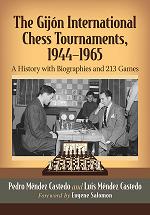
The Gijón International Chess Tournaments, 1944–1965
A History with Biographies and 213 Games by Pedro Méndez Castedo & Luis Mendez Castedo
2019
McFarland & Company,Inc.,Publishers Box 611
Jefferson,North Carolina 28640.
http://www.mcfarlandpub.com
244 pages
Price $45.00
ISBN: 978-1-4766-7659-3
The two Spanish chess amateurs Pedro Méndez Castedo & Luis Mendez Castedo have managed to write a fascinating read on the legendary International Chess Tournaments
of Gijón which where hold from the years 1944 till 1965.
Both authors have managed to dig down readable data from various sources and have included besides the 21 unique photographs biographical summaries
of all the players who have participated in this tournament.
The list of players is long as the 213 included games where many of them are excellent analysed in the context of that time.
It also features all tournament tables, winner’s biographies, and historical commentaries.
Alekhine did not win Gijón 1945 but the first price went to Antonio Rico 1908-1988 an amateur who was able to beat the best players of his time.
The following draw on Alekhine is more than impressive: Alekhine,Alexander - Rico Gonzalez,Antonio [B11]
Gijon IT Gijon (4), 15.07.1945
1.e4 c6 2.Nc3 d5 3.Nf3 Bg4 4.h3 Bxf3 5.Qxf3 e6 6.d4 Nf6 7.Bg5 Be7 8.0-0-0 Nxe4 9.Bxe7 Qxe7 10.Nxe4 dxe4 11.Qxe4 Nd7 12.Bd3 Nf6 13.Qe5 0-0-0 14.Bc4 Qc7 15.Qg5 Ne4 16.Qe3 Nd6 17.Bd3 Qa5 18.Kb1 Nf5 19.Bxf5 Qxf5 20.Rd3 Rd5 21.Rhd1 Rhd8 22.a3 h5 23.Ka1 Qg5 24.f4 Qe7 25.g4 hxg4 26.hxg4 Qd7 27.c4 Rd6 28.d5 exd5 29.Qxa7 Qc7 30.cxd5 Rxd5 31.Qa8+ Qb8 32.Rxd5 Rxd5 33.Qxb8+ Kxb8 34.Rxd5 cxd5 35.Ka2 Kc7 36.Kb3 Kd6 37.Kc3 g5 38.fxg5 Ke5 39.Kd3 Kf4 40.a4 Kxg5 41.a5 f5 42.gxf5 Kxf5 43.b4 Ke5 44.b5 Kd6 45.Kd4 Kc7 46.Kxd5 Kd7 47.Ke5 Kc7 48.Ke6 Kc8 49.Kd6 Kd8 50.Kd5 Kd7 51.Ke5 Kc7 52.Ke6 Kc8 53.Kd6 Kd8 54.b6 Kc8 55.Ke7 Kb8 56.Kd7 Ka8 57.a6 Kb8 58.a7+ Ka8 ½-½
Gijón was Alekhine’s downfall. He came only third, beaten by Arturo Bonet of Gijón and Antonio Medina,Champion of Spain.
Interesting are the words from Pablo Moran”A.Alekhine Agony of a chess genius McFarland 1989” We who witnessed this event were impressed by the efforts of a genius trying to surpass himself.One must stress that Alekhine took his losses with great sportsmanship.When Rico beat Lupi in the last round to come first,the world champion was the first to congratulate him with all sincerity.
On the cover of this book we see a lovely made photo from the Dutch player Lodewijk Prins against O’Kelly de Galway who was the third ICCF world champion of correspondence chess.
Lodewijk Prins 1913-1999 was the champion of Gijón 1947,and his name is related to the Prins Variation of the Günfeld Defence.
But against the former chess prodigy Arturo Salamanca Pomar he was just a little more lucky as we can see in the following game: Pomar Arturo- Prins Lodewijk [A49] Gijon IT Gijon 3-8-1947
1.Nf3 Nf6 2.b3 g6 3.Bb2 d6 4.d4 Bg7 5.g3 0-0 6.Bg2 Bf5 7.Nbd2 Qc8 8.0-0 Bh3 9.e4 Nh5 10.Rb1 c5 11.d5 Bxb2 12.Rxb2 Nf4 13.gxf4 Qg4 14.Nh4 Qxh4 15.Bxh3 Qxh3 16.Qf3 Qh6 17.Nc4 Nd7 18.f5 Qg7 19.Rbb1 gxf5+ 20.Kh1 fxe4 21.Qxe4 Qf6 22.Rg1+ Kh8 23.Rg3 Rac8 24.Rbg1 Rg8 25.Rxg8+ Rxg8 26.Rxg8+ Kxg8 27.Qg4+ Kf8 28.Qxd7 Qxf2 29.Qc8+ Kg7 30.Qg4+ Kf6 31.Qd1 Kf5 32.Qd3+ Kf4 33.Nd2 b5 34.Qe4+ Kg5 35.Qxe7+ Kh5 36.h4 Qxd2 37.Qxf7+ Kxh4 38.Qxh7+ Kg3 39.Qg6+ Kf3 40.Qf5+ Qf4 41.Qh3+ Kf2 42.Qg2+ Ke3 43.Kg1 Qf3 44.Qg5+ Ke2 45.Qg7 Qxd5 46.Qxa7 0-1,Under time pressure Pomar misses a easy win by 36.Qg5+! But on the other hand even in a inferior poor position, black plays for a win with 34…Kf5!?
The Champion of Gijón 1951 was the legendary Max Euwe and so far the best Dutch player of all time!
Conclusion: A wonderful made tribute to the legendary International Chess Tournaments of Gijón!
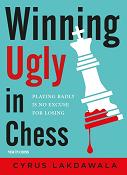
Winning Ugly in Chess: Playing Badly is No Excuse for Losing
by Cyrus Lakdawal
2019
New in Chess
http://www.newinchess.com/
336pages
Price € 22,95
ISBN: 978-90-5691-828-6
Most chess books only cover the moments of brilliant play but the great Lakdawala shows us in this book it is all a matter of who makes the last mistake.
This book is all a reminder of a difficult to accept fact, chess is like our actual life,it doesn’t always go the way we expect it to turn out,and
in this book you get the uncomfortable feeling that the wrong player won the game.
In big lines we must learn how to grab material and get away with it and some games in this book balance in a fine way between greed and generosity.
A fine example of how to fluster your opponent with an opening surprise is the following game from one of the greatest player of all time:
Fischer,Robert James - Gloger,J [A00]
Fischer tour simul Cleveland, 18.03.1964
1.b4 e5 2.Bb2 f6 3.e4 Bxb4 4.Bc4 Ne7 5.Qh5+ Ng6 6.f4 exf4 7.Nf3 Nc6 8.Nc3 Bxc3 9.Bxc3 d6 10.Nh4 Nce7 11.Nf5 Kf8 12.0-0 Qe8 13.Bxf6 Bxf5 14.exf5 d5 15.fxg6 gxf6 16.Qh6+ Kg8 17.g7 1-0, Lakdawala writes after 6.f4!? “The message from this move is clear:’I’m calling the shots now.” Technically this is slightly unsound, but keep in mind that Bobby Fischer isn’t likely to be intimidated by a simultaneous opponent, so he decides to play both an Evans Gambit and a King’s Gambit wrapped together in a single game.
More sensible was 6.Ne2 c6 7.f4 d5 8.exd5 b5 9.Bb3 0-0 10.a4!
Lakdawala prefers 8…Qe7! 9.0-0-0 Bxc3 10.Bxc3 d6 11.d4 Bd7 12.g3 0-0-0 and Lakdawala does not see any compensation for Bobby’s missing pawns.
On move 12.Bobby did miss the following blow 12.Bxf6!!
Included throw this wonderful read are 67 complete games and they are all well analysed !
Conclusion: This is highly educatieve learning material!
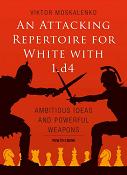
An Attacking Repertoire for White with 1.d4: Ambitious Ideas and Powerful Weapons
by Victor Moskalenko
2019
New in Chess
http://www.newinchess.com/
366 pages
Price € 29,95
ISBN: 978-90-5691-830-9
Grandmaster Viktor Moskalenko provides the reader with a well thought 1.d4 repertoire book based on powerful variations as for example :The King’s Indian Four Pawns Attack {with the exciting move order {5…0-0 6.Nf3 c5 7.d5 e6 8.dxe6!},Modern Benoni Defence with the Taimanov Attack. Again our author has a very pleasant suggestion for the reader and well the move: 1.d4 Nf6 2.c4 c5 3.d5 e6 4.Nc3 exd5 5.cxd5 d6 6.e4 g6 7.f4 Bg7 8.Bb5+ Nfd7 9.Be2!?
Viktor Moskalenko writes: This continuation seems very flexible and corresponds to my approach to openings: look for paths that are studied little and used rarely and that contain original hidden plans.
A fine example comes from the great master himself and I can insure the reader there are many more!
Moskalenko,Viktor (2543) - Fernandez Vicente,Carmelo (2100) [A67]
Sitges op 32nd Sitges (2), 22.07.2006
1.d4 Nf6 2.c4 e6 3.Nc3 c5 4.d5 exd5 5.cxd5 d6 6.e4 g6 7.f4 Bg7 8.Bb5+ Nfd7 9.Be2 Qh4+ 10.g3 Qe7 11.Nf3 0-0 12.0-0 Nb6 13.e5 Bg4 14.Ng5 Bxe2 15.Qxe2 dxe5 16.f5 N8d7 17.Nge4 f6 18.Be3 Nc8 19.Qg4 gxf5 20.Qxf5 Rf7 21.Nb5 b6 22.d6 Qf8 23.Nc7 Rb8 24.Rad1 Bh6 25.Bxh6 Qxh6 26.Ne8 Qf8 27.N8xf6+ Nxf6 28.Nxf6+ Kh8 29.Qxe5 Qg7 30.d7 1-0.
Other repertoire suggestions are:Slav Defence Exchange Variation, Nimzo-Indian with Sämisch and Kmoch Variations, Grünfeld Defence with the old pet line from Viktor Kortchnoi {5.Bd2!},and again our master of explanation comes with a smashing example:
Moskalenko,Viktor (2518) - Jerez Perez,Alfonso (2343) [D85]
Catalunya-ch Barcelona (9), 2000
1.d4 Nf6 2.c4 g6 3.Nc3 d5 4.cxd5 Nxd5 5.Bd2 Bg7 6.e4 Nxc3 7.Bxc3 c5 8.d5 Bxc3+ 9.bxc3 0-0 10.Bc4 Nd7 11.Nf3 Nb6 12.Qd3 Qc7 13.a4 Bd7 14.Bb5 c4 15.Qd4 Bxb5 16.axb5 Rfd8 17.h4 e6 18.h5 exd5 19.hxg6 fxg6 20.Ng5 Re8 21.Nxh7 1-0.
Again some words from Moskalenko:After a long think, in this extraordinary and dramatic position my opponent resigned due to the following variation:
21… Rxe4+ 22.Qxe4 dxe4 23.Nf6+ Kf8 24.Rh8+ Ke7 25.Rh7+ Kd8 26.Rd1+ Kc8 27.Rh8+ and checkmate in two moves.
Conclusion: One of those dangerous repertoire books!
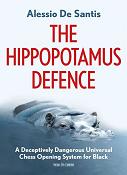
The Hippopotamus Defence: A Deceptively Dangerous Universal Chess Opening System for Black
by Alessio de Santis
2019
New in Chess
http://www.newinchess.com/
320 pages
Price € 29,95
ISBN: 978-90-5691-831-6
In the past there have been several books on the Hippopotamus,so as Grandmaster Tiger Hillarp Persson work, Tigers Modern and Andrew Martin’s interesting written The Hippopotamus Rises, but not one of these books comes close to this creative written work from the Italian Fide Master Alessio De Santis from Italy.
Alessio De Santis shows us that the Hippopotamus is more than a double Fianchetto where black develops within his own three ranks of the board, entering into no territorial struggles according to a fixed pattern of development.
First of all our author shows us new ideas in the Hippopotamus and explains in the same position the Hippopotamus sometimes strikes on the right,sometimes on the left.
This looks confusing but don’t worry,you only need to develop a good sensitivity for the position!
A fine example is here the modern move order: 1.e4 b6 2.d4 Bb7 3.Bd3 g6 4.f4 f5 5.exf5 Bxg2 6.fxg6 h5! and black gobbles the pawn and rook without getting mated:
Blomqvist,Erik (2334) - Skovgaard,Peter (2253) [B00]
Wch U18 Kemer (11), 28.11.2007
7.Nf3 Bxh1 8.Ng5 e6 9.Be3 Bg7 10.Nc3 Nh6 11.Qe2 Ng4 12.0-0-0 Bb7 13.d5 Nxe3 14.Qxe3 Qf6 15.dxe6 d5 16.Nh7 Rxh7 17.gxh7 d4 18.Qg3 dxc3 19.Rg1 Bh8 20.e7 Nc6 21.Qg8+ Kxe7 22.Re1+ Kd6 23.Bc4 cxb2+ 24.Kb1 Nd4 25.c3 Qf5+ 0-1.
But the most dangerous set-up against the Hippopotamus is the four pawn centre for example after 1.d4 g6 2.c4 Bg7 3.e4 d6 4.Nc3 Nd7 5.f4 black has probably nothing better than going into a King’s Indian type of opening, and there for we reach the question is the Hippopotamus good enough for top level correspondence computer chess?
Personally I have my doubts one slight mistake and the black player goes astray with his strategy of creeping around the edges.
But on the other hand this opening is unbelievable exciting!
I would like to end with my Hippopotamus hero,Maximilian Ujtelky who was more a theorist than a competitive player.
But he did manage to win the following game: Nezhmetdinov,Rashid - Ujtelky,Maximilian [B06] Chigorin Memorial-04 Sochi (1), 1964
1.e4 g6 2.d4 Bg7 3.Nc3 d6 4.Bc4 e6 5.Nf3 Ne7 6.h4 h6 7.Bf4 a6 8.Qe2 Nd7 9.a4 b6 10.Rd1 Bb7 11.Kf1 Nf8 12.Kg1 Qc8 13.Bb3 Qd7 14.Rh3 Rd8 15.Bc4 Qc8 16.Bb3 f6 17.Re1 Kf7 18.Bc1 c6 19.Nd2 d5 20.a5 b5 21.Nf3 Qc7 22.Bd2 Bc8 23.Na2 Nh7 24.Nb4 Rhe8 25.Nd3 Nf8 26.Bf4 Qxa5 27.e5 f5 28.Bd2 Qb6 29.Ra1 Nh7 30.Ba5 Qa7 31.Bxd8 Rxd8 32.Qd2 Bb7 33.Qa5 Ra8 34.Nc5 Bc8 35.c3 Nf8 36.Ne1 Bxe5 37.dxe5 Qxc5 38.Nd3 Qa7 39.Bc2 c5 40.b4 Nc6 41.Qa3 c4 42.Nc5 Nxe5 43.Qc1 h5 44.Rg3 Ned7 45.Nxe6 Nxe6 46.Qh6 Ndf8 47.Bxf5 gxf5 48.Re1 Bd7 49.Qxh5+ Ke7 50.Qxf5 Kd6 51.h5 a5 52.Qe5+ Kc6 53.Rd1 Nc7 54.Ra1 Qb8 55.bxa5 b4 56.cxb4 Qxb4 57.Rf3 Nce6 58.a6 Qc5 59.Qe1 Nd4 60.Rf6+ Nfe6 61.Ra5 Qb6 62.h6 Kd6 63.h7 c3 64.Ra1 c2 65.Rg6 Rh8 66.a7 Qb2 67.Rh6 Ne2+ 68.Kh2 c1Q 69.Rxc1 Nxc1 70.Qa5 Bc6 71.Qa6 Qe5+ 72.g3 Nb3 73.f4 Qb2+ 74.Kh3 Nbc5 75.a8Q 0-1.
As Alessio De Santis explains after 18...c6 : With all his pawns on the third rank,black has played a Hippopotamus that’s more unique than rare.
Some authors in the past used to identify this as the Hippopotamus set-up, but it fell into disuse.
The experiment should probably not be repeated: the position is better for white and black’s win should be considered fortunate.
Conclusion: A must for all players who enjoy creative chess!
Chess DVD's
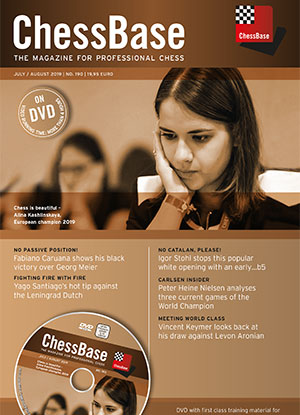
ChessBase Magazine issue 190
July - August 2019
ChessBase
http://www.chessbase.com
E-Mail info@chessbase.com
ISSN 1432-8992
Euro 19.95
System requirements:
Minimum: Pentium III 1 GHz, 1 GB RAM, Windows Vista, XP (Service Pack 3), DirectX9 graphic card with 256 MB RAM, DVD-ROM drive, Windows Media Player 9, ChessBase 12/Fritz 13 or included Reader and internet connection for program activation. Recommended: PC Intel Core i7, 2.8 GHz, 4 GB RAM, Windows 8.1 or Windows 10, DirectX10 graphic card (or compatible) with 512 MB RAM or better, 10
Some high lights of this super made issue are : Fabiano Caruana shows his black victory over Georg Meier, Fighting fire with fire where Yago Santiago’s hot tip against the Leningrad Dutch, No Catalan, por favor! Igor Stohl stops this popular white opening with an early…b5, Carlsen insider Peter Heine Nielsen analyses three current games of the World Champion Meeting world class
Vincent Keymer looks back at his draw against Levon Aronian “If you are thrown out of your preparation, you should react aggressively!“
Alina Kashlinskaya (cover) looks back at the victory which paved her way to become new European champion.Ladies to the fore!
Oliver Reeh presents 29 tactical highlights from the European Women’s Ch Theoretically explosive Rainer Knaak demonstrates a trap in the French Steinitz Variation (Video).Carlsen's mighty bishop pair
Let Karsten Müller explain to you an instructive model game from Shamkir (Video) Rising stars
Get to know two of the greatest chess hopes from India, Nihal Sarin and Gukesh! (Video)
But there is more: As the following opening files,Lars Schandorff checks 5.b3 in the Symmetrical English A36 1.c4 g6 2.Nc3 Bg7 3.g3 c5 4.Bg2 Nc6 5.b3,Benoni A70 1.d4 Nf62.c4 c5 3.d5 e6 4.Nc3 exd5 5.cxd5 d6 6.Nf3 g6 by Romain Edouard,Dutch Leingrad System A85 1.d4 f5 2.c4 Nf6 3.Nf3 g6 4.Nc3 Bg7 5.Bf4!? 0-0 6.e3 d6 7.c5 by Yago Santiago’s,Caro-Kann B11,1.e4 c6 2.Nc3 d5 3.Nf3 Bg4 4.h3 Bxf3 5.Qxf3 e6 6.d4 Nf6 7.Bd3 dxe4 8.Nxe4 by Evgeny Postny,Sicilian Sveshnikov B33 1.e4 c5 2.Nf3 Nc6 3.d4 cxd4 4.Nxd4 Nf6 5.Nc3 e5 6.Ndb5 d6 7.Bg5 a6 8.Na3 b5 9.Nd5 Be7 10.Bxf6 Bxf6 11.c3 Bg5 12.Nc2 by Robert Ris,Sicilian Rauzer Variation B69
1.e4 c5 2.Nf3 d6 3.d4 cxd4 4.Nxd4 Nf6 5.Nc3 Nc6 6.Bg5 e6 7.Qd2 a6 8.0-0-0 Bd7 9.f4 Be7 10.Nf3 b5 11.Bxf6 gxf6 12.Kb1 Qb6 13.f5 0-0-0, French C00 1.e4 e6 2.Qe2 by Viktor Moskalenko,Scotch Four Knights C47 1.e4 e5 2.Nf3 Nc6 3.Nc3 Nf6 4.d4 exd4 5.Nxd4 Bb4 6.Nxc6 bxc6 7.Bd3 d5 8.exd5 0-0 9.0-0 Bg4 by Alexey Kuzmin,
Ruy Lopez Exchange Variation C68 1.e4 e5 2.Nf3 Nc5 3.Bb5 a6 4.Bxc6 dxc6 5.0-0 Qf6 by Petra Papp,Queen’s Gambit Accepted D25 1.d4 d5 2.c4 dxc4 3.Nf3 Nf6 4.e3 Bg4 by Roert Hungaski and at last the King’s Indian E95 with the moves 1.d4 Nf6 2.c4 g6 3.Nc3 Bg7 4.e4 0-0 5.Nf3 d6 6.Be2 e5 7.0-0 Nbd7 8.Re1 Re8.
The highly wanted main data file is good for 1152 entries and where a small 27 of them are more than excellent analysed.
A fine example is:
Vallejo Pons,Francisco (2693) - Carlsen,Magnus (2845) [C78]
GRENKE Chess Classic 6th Karlsruhe/Baden Baden (2), 21.04.2019
[Krasenkow,Michal]
1.e4 e5 2.Nf3 Nc6 3.Bb5 a6 4.Ba4 Nf6 5.0-0 Bc5 6.c3 0-0 7.d4 Ba7 8.dxe5 Nxe4 9.Bc2 [9.Qd5 is the main move in this position. A recent example from the World Champion's practice: 9...Nc5 10.Bc2 Ne7 11.Qd1 d5 12.exd6 Qxd6 13.Qxd6 cxd6 14.Rd1 (14.Re1 Re8 15.Be3 Bf5 16.Na3 Bxc2 17.Bxc5 dxc5 18.Nxc2 Nc6= 1/2 (84) Vachier Lagrave,M (2780)-Fressinet,L (2640) Brest 2019) 14...Bg4!? 15.Rxd6 Bf5! 16.Na3 Ne4 17.Bxe4 Bxe4 18.Rd1 Nf5 19.Nc4 Rfe8 20.Be3 Bxe3 21.Nxe3 Nxe3 22.fxe3 Bxf3 23.gxf3 Rxe3 24.Rd7 Rb8= 1/2 (41) Karjakin,S (2782)-Carlsen,M (2843) Stavanger 2018] 9...d5 10.exd6 Nxd6 11.Bg5 f6 12.Bf4 g5!?N A curious concept. Magnus Carlsen complicates (disbalances) the position. There have been two old games which continued: [12...Bg4 13.Qd3 Bf5 14.Qd5+ Kh8 15.Bxf5 Ne7 16.Qb3 Nexf5 17.Nbd2 Qd7 18.Rad1 Qc6= 1-0 (62) Gurnhill,C-Blake,J Edinburgh 1926;
12...Kh8 13.Bxd6 cxd6 14.Qd5 Ne5 15.Nbd2 Bd7?! (15...Qc7) 16.Qxd6?! (16.Nxe5 fxe5 (16...dxe5 17.Qxb7 Bb5 18.Rfd1 Be2? 19.Qe4) 17.Qxb7± .Bb5? 18.c4) 16...Bb5 17.Qxd8 Raxd8 18.Rfe1 Ng4 19.Nd4 Rxd4! 20.cxd4 Bxd4© 0-1 (35) Horn,C-Gabinara,A San Marino 1950] 13.Bxd6 [13.Bg3 f5!? 14.Qd5+ Nf7! 15.Qxd8 Rxd8 .16.Bxc7? Rd7 17.Bg3 f4] 13...Qxd6 14.Qxd6 cxd6 15.Nbd2 [15.Bb3+!? Kg7 16.Na3 preventing ...d6-d5 16...Bg4! 17.Bd5 Rae8÷] 15...g4 [¹15...d5÷] 16.Nh4 d5 17.Nf5 [¹17.Rfe1 d4 (17...Bd7 18.Bb3) 18.Rad1 creating a kind of domination in the centre but that was not easy to evaluate!] 17...d4 18.Nc4 Bxf5 19.Bxf5 h5= The position is roughly equal but complicated enough for the World Champion to outplay his opponent. 20.Rad1 Rfd8 21.a4 Ne7 22.Be6+ Kg7 23.Rfe1 f5 24.Na5 Rab8 25.Kf1 Kf6 26.Bb3 Ng6 27.Re6+ Kg5 28.g3 dxc3 29.bxc3 Rxd1+ 30.Bxd1 Rd8 31.f4+!? gxf3 32.Bxf3 h4 33.Nc4 [33.Bxb7 Rd2 34.gxh4+ Nxh4 35.Rxa6÷ looked too risky to White but after the text move the initiative firmly belongs to Black.] 33...hxg3 34.hxg3 Bb8 35.Kg2 b5 36.axb5 axb5 37.Ne3? [37.Na3! f4 38.Be4 Nf8 39.Rb6 fxg3 40.Rxb5+ Kf4 41.Rd5 Re8 42.Bf3 Ng6 43.Rd4+ Kf5 44.Nc4=] 37...Rd2+ [37...f4! 38.Be4 Nf8 39.gxf4+ Bxf4 40.Rb6 Bxe3 41.Rxb5+ Kf4µ] 38.Kh3 Rd3 39.Be2 Rxc3 40.Bxb5 f4 41.Be8 Nf8 42.Rb6 Be5 [42...fxe3 43.Rxb8 e2 44.Rb1 Re3 45.Re1 Rxe8 46.Kg2=] 43.Nf1 fxg3 44.Rc6 Ra3 45.Rb6 Ra2 46.Rb4 Ne6 47.Rg4+ Kf6 48.Bc6? [48.Rxg3! Bxg3 (48...Ng5+ 49.Kg4) 49.Kxg3 is a theoretical draw while "R+B vs B+N" is theoretically won in case of opposite-coloured bishops. True, that position is very difficult. I failed to score a victory against GM Kivanc Haznedaroglu in a similar situation but Magnus Carlsen manages it much better.] 48...g2! 49.Bxg2 Nf4+ 50.Rxf4+ Bxf4 51.Bf3 Bb8 52.Ng3 Kg5 53.Ne2 Bc7 54.Kg2 Kh4 55.Kf2 Bb6+ 56.Ke1 Be3 57.Kd1 Kg5 58.Be4 Kf6 59.Bf3 Ke5 60.Bg2 Kd6 61.Be4 Kc5 62.Bf5 Rd2+ 63.Ke1 Rd8 64.Be4 Kc4 65.Kf1?! [This endgame is almost impossible to explain. For some reason, 65.Ng3 was better. If 65...Re8 then 66.Bg6] 65...Rf8+ 66.Ke1? [And here the stalemate trick 66.Kg2!! Rf2+ 67.Kh1!! was White's last chance to continue resistance. 67...Rxe2?? 68.Bd3+! Kxd3=] 66...Bf2+! Black forces White's king to the a1 corner and mates it there. 67.Kd2 [67.Kf1 Bc5+ 68.Ke1 Bb4+ 69.Kd1 Rd8+ 70.Kc1 Bd2+ 71.Kc2 Be3 leads to the same outcome.] 67...Rd8+ 68.Kc2 Be3 69.Bf3 Rd2+ 70.Kb1 Kb3 71.Nc1+ Ka3 72.Ne2 Rb2+ 73.Ka1 Rb8 0-1.
One of my favourite column comes from
The great endgame professor Karsten Müller.
This and much more comes with a eye catching booklet!
Conclusion:Super material!

ChessBase Magazine extra issue 189
June 2019
Videos by Adrian Mikhalchishin,Mihail Marin Yannick Pelletier and Georgios Souleidis.
ChessBase
http://www.chessbase.com
E-Mail info@chessbase.com
ISSN 1432-8992
Euro 12.99
System requirements:
Minimum: Pentium III 1 GHz, 1 GB RAM, Windows Vista, XP (Service Pack 3), DirectX9 graphic card with 256 MB RAM, DVD-ROM drive, Windows Media Player 9, ChessBase 12/Fritz 13 or included Reader and internet connection for program activation. Recommended: PC Intel Core i7, 2.8 GHz, 4 GB RAM, Windows 8.1 or Windows 10, DirectX10 graphic card (or compatible) with 512 MB RAM or better, 100% DirectX10 compatible sound card, Windows Media Player 11, DVD-ROM drive and internet connection for program activation.
This time I even founded four smashing video files on this well loaded DVD and well: Mihail Marin’s English love tested in practice, An English Gambit 1.c4 e6.2.g3 d5 3.Bg2 a6 4.Nf3 dxc4 5.0-0 b5 6.d3,Yannick Pelletier Anti London part3 and at last a interesting one from Adrian Mikhalchishin on Anatloy Karpov match against Garry Kasparov.
The Hugh game file is well overloaded with 41531 entries and all played between 8/4 and 24/5 of this year.
A interesting extra is the so called Extra lucky bag which holds 39 well analysed games.
Conclusion: Top class chess material for a bargain price!
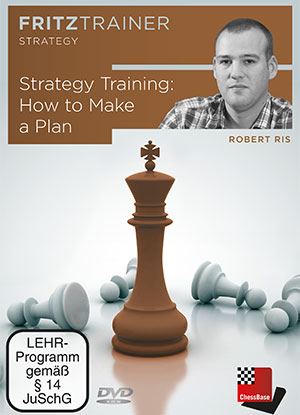
Strategy Training: How to Make a Plan
by Robert Ris
2019
http://www.chessbase.com
E-Mail info@chessbase.com
Price Euro 29.90
Minimum: Dual Core, 2 GB RAM, Windows 7 or 8.1, DirectX11, graphics card with 256 MB RAM, DVD-ROM drive, Windows Media Player 9, ChessBase 14/Fritz 16 or included Reader and internet access for program activation. Recommended: PC Intel i5 (Quadcore), 4 GB RAM, Windows 10, DirectX11, graphics card with 512 MB RAM or more, 100% DirectX10-compatible sound card, Windows Media Player 11, DVD-ROM drive and internet access for program activation.
The master of explanation Robert Ris provides the user with a well made training DVD based on five important key elements of positional play and well, The influence of pawn play
How to deal with tension (with pawns and pieces),Improving your worst piece, Creating targets & exploiting them and at last the so important Prophylactic thinking.
After working throw the examples files there are a small 100 self tests waiting for you to solve!
Included is also a new feature in the Fritz app to play out various positions.
Video running time is a impressive 8 hours!
Conclusion: Great learning DVD!
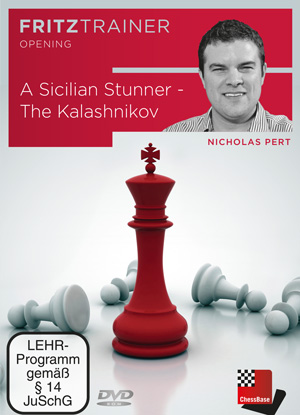
A Sicilian Stunner - The Kalashnikov
by Nicholas Pert
http://www.chessbase.com
E-Mail info@chessbase.com
Price Euro 29.90
Minimum: Dual Core, 2 GB RAM, Windows 7 or 8.1, DirectX11, graphics card with 256 MB RAM, DVD-ROM drive, Windows Media Player 9, ChessBase 14/Fritz 16 or included Reader and internet access for program activation. Recommended: PC Intel i5 (Quadcore), 4 GB RAM, Windows 10, DirectX11, graphics card with 512 MB RAM or more, 100% DirectX10-compatible sound card, Windows Media Player 11, DVD-ROM drive and internet access for program activation.
The great Nicholas Pert comes with a heavy loaded coverage of the famous Kalashnikov,where black stakes a blow in the centre and sets the tone for the rest of the game.
The starting position of the Kalashnikov runs with the moves 1.e4 c5 2.Nf3 Nc6 3.d4 cxd4 4.Nxd4 e5 5.Nb5 d6.Now white has two main options,The first is 6.c4 and the other one is 6.N1c3.
Both are more than excellent covered here.
Better and much more up to date than for example the older work from Pinski and Aagaard on the Kalashnikov!
Covered in a impressive five hours video time are 29 impressive analyses, a instructive example game from Pert himself and 15 self tests to see if you have understood the exciting video lessons.
Included is a extra training chapter with repertoire and play features.
Conclusion: This is a very important reference coverage of the Kalashnikov!
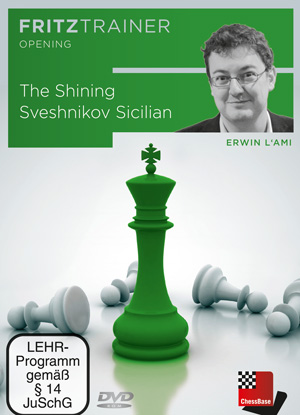
The Shining Sveshnikov Sicilian
by Erwin l'Ami
http://www.chessbase.com
E-Mail info@chessbase.com
Price Euro 29.90
Minimum: Dual Core, 2 GB RAM, Windows 7 or 8.1, DirectX11, graphics card with 256 MB RAM, DVD-ROM drive, Windows Media Player 9, ChessBase 14/Fritz 16 or included Reader and internet access for program activation. Recommended: PC Intel i5 (Quadcore), 4 GB RAM, Windows 10, DirectX11, graphics card with 512 MB RAM or more, 100% DirectX10-compatible sound card, Windows Media Player 11, DVD-ROM drive and internet access for program activation.
The Dutch grandmaster provides the user of this DVD with a mass of analyses and video files on the Sveshnikov,a fascinating opening where black accepts an apparently loose structure but on the other hand black gets a lot of piece activity.
Covered on this DVD are all the main lines with up to the minute coverage of all the variations included the modern line with 7.Nd5.Where white abandons the idea of exploiting the d5 square and the weakness of black’s backward pawn.
A small view of the index of this DVD:
02: 11.c3 Ne7 12.Nc2 Nxd5 - Video notation [06:07]
03: 11.c3 Ne7 12.Nxf6 gxf6 13.Bd3/Be2 d5 - Video notation [06:43]
04: 11.c3 Ne7 12.Nxf6 gxf6 13.Nc2 Bb7 14.Bd3 d5 15.Qe2 dxe4 - Video notation [14:21]
05: 11.c3 Ne7 12.Nxf6 gxf6 13.Nc2 Bb7 14.Bd3 d5 15.exd5 Qxd5 - Video notation [16:46]
06: 11.c3 Ne7 12.Nxf6 gxf6 13.g3 Bb7 - Video notation [13:31]
07: 11.c3 Bg5 12.Nc2 Ne7 - Video notation [22:57]
Main Line 9.Bxf6
01: 11.Bxb5 axb5 12.Nxb5 Bb7 - Video notation [13:40]
02: 11.c3 Bg7 12.exf5 Bxf5 13.Nc2 0-0 14.Nce3 Be6 15.Bd3 f5 16.Bc2 f4/Kh8 - Video notation [15:45]
03: 11.c3 Bg7 12.exf5 Bxf5 13.Nc2 0-0 14.Nce3 Be6 15.Bd3 f5 16.Qh5 e4 - Video notation [06:45]
04: 11.c3 Bg7 12.exf5 Bxf5 13.Nc2 0-0 14.Nce3 Be6 15.Bd3 f5 16.0-0 e4 - Video notation [08:51]
05: 11.Bd3 Be6 12.Qh5 Rg8 - Video notation [07:05]
06: 11.Bd3 Be6 12.c3 Bg7 - Video notation [11:04]
07: 11.Bd3 Be6 12.0-0 Bxd5 - Video notation [29:21]
New Main Line 7.Nd5
Included is a training chapter with repertoire and play features,plus instructional games in a move-by-move format and “memory markers” which help you remember the theory.
Video running time: 8 hours (English)
Conclusion: This is ChessBase on it’s best!